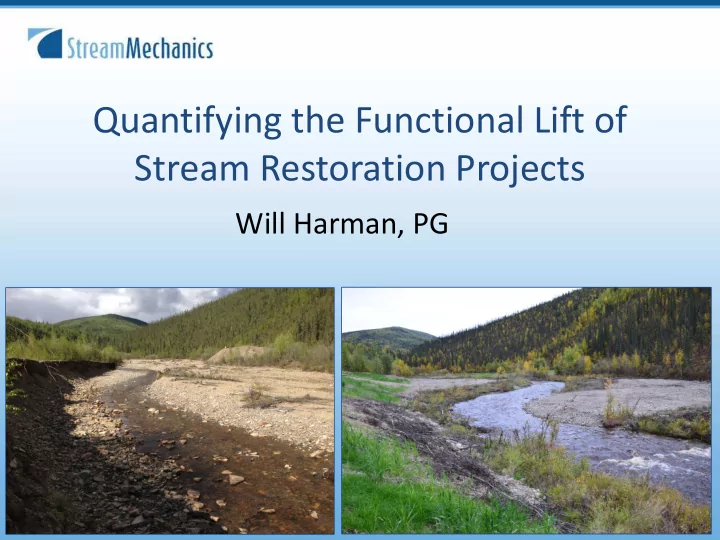

Quantifying the Functional Lift of Stream Restoration Projects Will Harman, PG
Purpose of the Quantification Tool 1. Determine numerical differences between an existing (degraded) stream condition and the proposed (restored) stream condition. Credit Determination Method – 2. Link restoration activities to changes in stream functions (function-based parameters). 3. Link restoration results to restoration potential. 4. Incentivize high-quality stream mitigation.
How can the tool be used? • Site Selection—Does a project reach have enough functional lift and overall quality to justify as a project? Can use rapid assessment methods. • Quantify functional lift or loss • Stream mitigation credits – For existing ratio methods, as a way to select the ratio. – Simply use the functional foot delta for new methods. – Not rapid, but not too intensive. • Permittee Responsible Mitigation – Can the proposed mitigation activities offset the predicted losses in stream functions. • Debit Side – Coming in 2016
Excel Workbook (For One Reach) Five Worksheets: • Project Assessment • Catchment Assessment • Parameter Selection Guide • Quantification Tool • Performance Standards
Terms You Need to Know Functional Function-Based Measurement Performance Category Parameter Method Standard 1. Hydrology Function or Quantifies the Functional 2. Hydraulics condition metrics parameter. There capacity. 3. Geomorphology that describes may be more 4. Physicochemical functions within than one per Functioning 5. Biology the functional parameter. category. Functioning- At-Risk Based on the Stream Functions Pyramid Framework: Harman, W., R. Starr, M. Carter, K. Tweedy, M. Clemmons, K. Suggs, Not and C. Miller. 2012. A Function-Based Framework for Stream Functioning Assessment and Restoration Projects. U.S. Environmental Protection Agency, Office of Wetlands, Oceans, and Watersheds, Washington, DC. EPA 843-K-12-006.
Quantification Tool: Inputs Site Information and Performance Standard Stratification Project Name: Kraft Reach ID: 1 • Project Information Restoration Potential: Level 3 - Geomorphology • Stratification that Existing Stream Type: E determines the Proposed Stream Type: C performance standards Region: Mountains Drainage Area (sqmi): 4 to use. Proposed Bed Material: Gravel • Selected from pull- Existing Stream Length (ft): 736 down menu. Proposed Stream Length (ft): 957 Stream Slope (%): 0.62 Flow Type: Perennial River Basin: Yadkin-PeeDee Stream Temperature:
Quantification Tool: Scoring Not Functioning Functioning-At-Risk Functioning 0.0 - 0.29 0.3 – 0.69 0.7 – 1.0
Performance Standards Pool-to-pool spacing is a Measurement Method for Bedform Diversity within the Geomorphology Functional Category.
Quantification Tool: Existing and Proposed Condition Assessment Functional Function-Based Measurement Method Field Value Index Category Parameters Value Catchment Catchment Assessment H1, H2, H3 0 to 1.0 Hydrology M1, M2, M3 L1,L2, L3 Hydrology Runoff Storm EZ & Impervious 0 to 100% 0 to 1.0 Cover (%) Flow Duration NATHAT-DHRAM Model result 0 to 1.0 Floodplain Bank Height Ratio 1 to ___ 0 to 1.0 Hydraulics Connectivity Entrenchment Ratio 1 to ___ 0 to 1.0 Pool-to-pool spacing 0 to ___ 0 to 1.0 Bed Form Geomorphology Diversity Depth Variability Ratio 0 to ___ 0 to 1.0 Physicochemical Biology
Roll Up Scoring • Measurement Method Index Scores are averaged to create Parameter Score. • Parameter Index Scores are averaged to create Functional Category Scores. • Category Scores are multiplied by 0.2 and summed to create Overall Score. – Max Score through Level 3 Geomorphology = 0.6 – Max Score through Leve 4 Physicochemical = 0.8 – Max Score through Level 5 Biology = 1.0
Basic Rules • Same parameters evaluated for existing and proposed conditions. • Must include catchment health, floodplain connectivity, bed form diversity, lateral stability, and riparian vegetation. • Add other parameters based on specific scenarios and environments, e.g., adjacent BMP, cattle access, forested reference conditions,etc. • Practitioners cannot change parameters, measurement methods or performance standards without approval of regulatory agency/owner.
Results • Existing Condition Score (ECS) • Proposed Condition Score (PCS) Condition Lift • Condition Lift = PCS- ECS • Percent Condition Lift • Existing Functional Feet – Existing Stream Length X ECS Functional Feet Lift • Proposed Functional Feet – Proposed Stream Length X PCS • Functional Lift – Proposed Functional Feet – Existing Functional Feet • Percent Lift from Functional Feet
Hypothetical Example Existing Condition
Construction
2007 2002 2006
Functional Lift Summary Exisiting Condition Score 0.36 Proposed Condition Score 0.74 Functional Lift Score 0.38 Percent Condition Lift (%) 106 Existing Stream Length (ft) 736 Proposed Stream Length (ft) 957 Additional Stream Length (ft) 221 Existing Functional Foot Score 265 Proposed Functional Foot Score 708 Proposed Functional Foot Score - Existing Functional Foot Score 443 Functional Lift (%) 167
Functional Lift Summary Functional Category Function-Based Parameters Existing Parameter Proposed Parameter Hydrology Catchment Hydrology 0.4 0.4 Hydrology Runoff Hydrology Flow Duration Hydraulics Floodplain Connectivity 0.5 1.0 Geomorphology Large Woody Debris 0.1 0.58 Geomorphology Lateral Stability 0.42 1 Geomorphology Riparian Vegetation 0.53 0.76 Geomorphology Bed Material Composition Geomorphology Bed Form Diversity 0.59 1.0 Geomorphology Sinuosity 0.70 0.93 Physicochemical Temperature Physicochemical Salinity Physicochemical Bacteria 0.0 0.79 Physicochemical Stream Metabolism Physicochemical Organic Matter 0.50 0.90 Physicochemical Nitrogen Physicochemical Phosphorus Biology Macros 0.36 0.60 Biology Fish 0.0 0.61
Functional Category Summary
Case Study Results
Case Study Results
Key Acknowledgements • Environmental Defense Fund (Funding) – Will McDow, Project Manager • Ecosystem Planning and Restoration – Cidney Jones, PE, Spreadsheet Development and Research • NC Division of Mitigation Services – Periann Russell, Greg Melia, Michael Ellison, Lin Xu – Parameter selection, case studies, testing, modeling develop. • NC Division of Water Resources – Eric Fleek and Larry Eaten, Biological parameter support • Watershed Science – Dave Penrose, Physicochemical and biological support
Questions Will Harman, PG Stream Mechanics www.stream-mechanics.com www.Facebook.com/StreamMechanics wharman@stream-mechanics.com
Recommend
More recommend